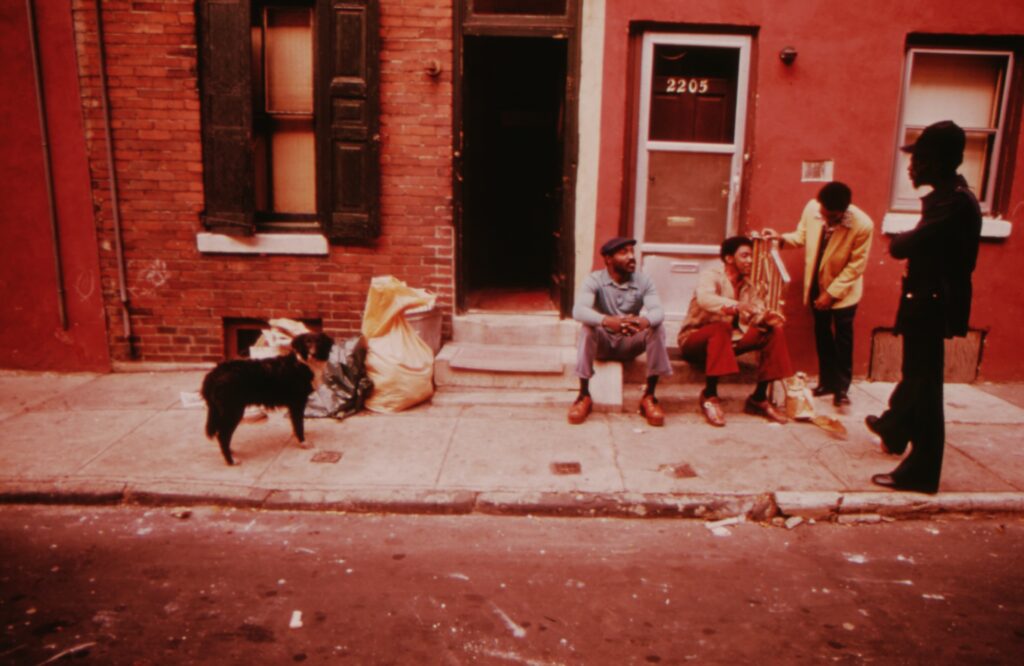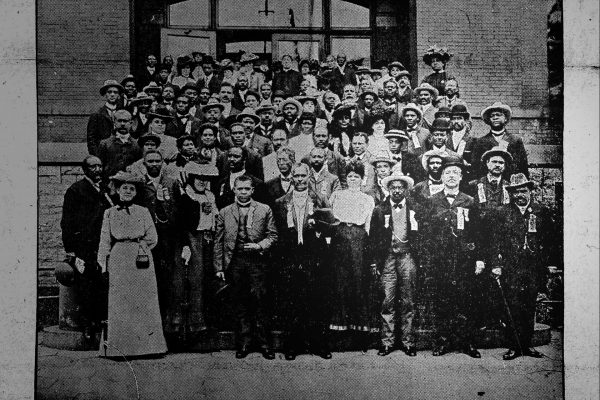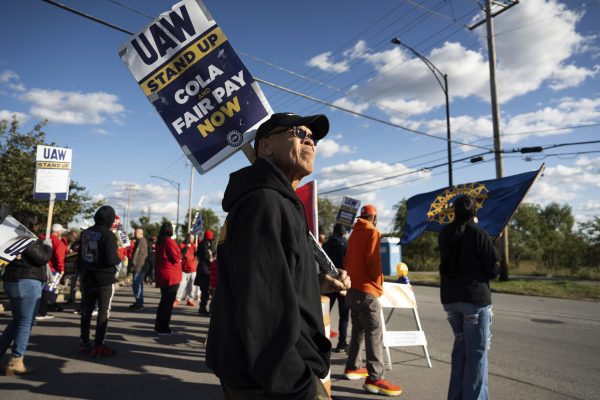In July 2017, Philadelphia councilmember Cherelle Parker (now the city’s Democratic mayoral nominee) and residents of East Mount Airy blocked developers’ plans to demolish an older house and replace it with two new homes. Residents rightly recognized the project as the beginning of gentrification in their majority Black neighborhood, and they had initially simply requested building materials consistent with the neighborhood. Parker appealed to the Department of Licenses and Inspections and the Zoning Board to revoke the company’s permit until further notice for violating the department’s policy on demolition notification postings. The developer ignored the ruling and proceeded with plans to tear down the property. As a last attempt, Parker and her constituents locked arms and obstructed a bulldozer’s access to the construction site. “The action was the recourse of a community,” Parker stated, “that had no other options.” Eventually, the residents and Parker won. This communal standoff against the developer is part of a long history of Black Philadelphians fighting for their space and ownership of their neighborhoods in the “City of Brotherly Love.”
In this interview, I spoke to historian J.T. Roane in May about his recent book Dark Agoras: Insurgent Black Social Life and the Politics of Place. The book charts a history through Philadelphia’s working-class Black communities from the Great Migration to the Black Power era as they navigated the city’s complex social terrain to reconstitute and claim spatial presence. Roane examines Philadelphia’s “underground” (stoops, gambling houses, and unlicensed bars) and spiritual spaces (house and storefront congregations, temples, and mosques) to uncover how Black people’s quotidian practices and the work of local organizations constituted a spatial politics. In our conversation, we discussed his work, the significance of geography, and modes of resistance against dominant arrangements of urban political economy in the spaces he calls “dark agoras.”
—N’Kosi Oates
N’Kosi Oates: Let’s begin with W. E. B. Du Bois, because one of his foundational works as a sociologist was The Philadelphia Negro, published at the end of the nineteenth century. Your book also explores black urban life in Philadelphia—you’re looking at the twentieth century and use a historian’s lens instead. How do you expand upon and even depart from Du Bois’s important work?
J.T. Roane: Because Dark Agoras centers on Philadelphia, it is critical to begin with Du Bois’s work. His engagement with Black Philadelphia at the end of the nineteenth century, is, of course, the primary opening of sociology in the American context. But while Du Bois is engaged with working-class Black life, he can also be derisive and dismissive of it, especially around what he sees as its inability to fully integrate into the social fabric of the city—even as he’s challenging the naturalization of Blackness as segregated and exterior to the normative functioning of the city.
Even so, Dark Agoras is indebted to Du Bois. I pick up his engagement with both the city’s underground and the kind of social worlds associated with what I call Philadelphia’s “set-apart,” the various religious and social spatial formations that took shape after the period that he’s writing about in the 1890s.
NO: I’m interested in the relationship between the underground and the set-apart, both of which, in your work, are kinds of “dark agoras.” In which ways do these two sets of communities overlap?
JTR: Both the underground and the set-apart emerged from the dynamics of segregation. But many of the people who are engaged in the Black set-apart religious and spiritual communities distance themselves pretty explicitly from the economic and the sexual and other kinds of disreputable worlds associated with the underground. Yet even in diametric opposition, there’s so much shared energy between those two spaces.
Some of the energy between these two formulations of dark agoras comes out of migrants’ transposition, of practices and worlds that they had made, first on plantations and then through the movement to mill towns and small agricultural towns in the South, and into the urban South, and then through the Great Migrations into Northern urban geographies like Philadelphia or Chicago.
NO: Until reading your book, I hadn’t thought about mapping the underground not simply to various activities, but to geography or spatiality. Can you tell me why geography is a useful analytic here?
JTR: Well, the underground has its own kind of urban coordinates that reflect the larger capitalist organization of cities as structured by the economy outside of it, but also map to spaces where people create their own senses of value. That applies to the set-apart as well. When you overlay those two worlds, they co-create a kind of epistemological or phenomenological approach to the city that exceeds, even if it sometimes overlaps with, the city as property, the city as the creator of a certain kind of value.
Subscribe to our newsletter to get our latest essays, archival selections, and exclusive editorial content in your inbox.
That’s the generative part about geography—making it an axis of analysis alongside time opens up the reality that multiple temporalities can coincide. Geography opens not only the kind of a more robust understanding of how vulnerability is created through infrastructures but, I think, also opens up what we might understand as a kind of Black spatial politics or a Black spatial tradition.
NO: I think a great example of one of the geographic sites you discuss is the stoop. In your book, you argue that the stoop stands as one of the places that constitute the underground. How does this domestic exterior transform into a vital place for sociality?
JTR: The stoop has a whole genealogy. The Black uses of the stoop emerge out of the uses of the quarters in the context of the plantation. If you go back to slave narratives, Black communities articulated a whole kind of social existence that was integrally related to their geographic position to the side of the major formation of the plantation—the big house—and to the spaces of labor, the field. In the spaces around cabins, Black communities created gardens and other forms of social reproduction. These spaces, as Sylvia Wynter has argued, allowed Black communities to produce other values, outside of where their labor served financial gain through the land as property.
When Black communities get displaced during the Jim Crow enclosures, in particular in the late nineteenth century and early twentieth century, they don’t just relinquish those values. I think that gets grafted onto the stoop. This kind of space is in many ways architecturally significant but banal. It’s like a passageway. It’s a point between the street and the interior.
But I don’t want to romanticize it. In part, the history of the stoop is about the limited space that Black communities had, and reflects the financially lucrative nature of Jim Crow segregation, because creating a fine life in what’s considered architecturally just an in-between space is not a romance. Packing people into a small geography was profitable, especially to absentee landlords in the context of Philly. But the stoop, the corner, the rooftop—Black communities infuse these spaces with a certain vitality. Of course, this was well before the kinds of architectural projects in gentrified space that we see today, like the use of rooftops. These are unscripted uses of spaces. They’re creating a sense of fugitive values that extend beyond the norms of who should be where in a racial capitalist organization of a city. The rooftop, the stoop, and the uses of these places really bring to life an ongoing alternative engagement with the city.
NO: What’s also fascinating about the stoop or the rooftop is that it’s perilous. You don’t have the protection or privacy of being in an enclosed space. The stoop is a vessel to the street. It’s part of the outside, and therefore, it’s subject to more surveillance.
JTR: Yes, that’s the kind of dynamic that the book traces from the plantation context into post-emancipation life and into urban contexts through the Great Migrations—it is a geographic dialectic that emerges between Black placemaking and the desire to contain Black life, to appropriate it, expropriate it, and also to render it disposable as part of the logics of extraction. Again, it’s definitely not a romantic story.
NO: In thinking about laying claims to geography, talk to me about how citizenship, both upstanding and criminalized, was articulated through property.
JTR: In the book, I emphasize property as a stabilizing force—like nuclear familial life—within urban industrial modernity, partly because of understandings that emerge out of the late nineteenth century. But it also aligned itself with the emergent science of the city, which is planning. The tenement laws that emerged in places like New York City were characteristically articulated as reform, but they were often reinforced through property laws normalizing hierarchy and exclusion.
When we get to the Keynesian organization of the political economy in the mid-twentieth century, the model still unrelentingly centers on home ownership in the landscape. Of course, if we follow those deeds back, those all come from expropriated indigenous titles—violent, genocidal formations of land and property. Here I’m thinking with K. Sue Park’s important legal scholarship.
I think the fool’s errand of mid-twentieth century city planning was the effort to ameliorate the unevenness of geographies of capital without addressing racial capitalist property organization. Even though progressive and post-progressive urban planners knew that uneven geographies were socially produced, they turned to an intellectual context of eugenics and anti-Blackness as a way of understanding it.
For example, they relied heavily on an environmentalist strain within sociological understandings that recently arrived Black Southerners had to be stamped out—that the peculiarity of their geography had to be eradicated. Planners like Edmond Bacon and architects like Louis Kahn and Oscar Stonorov, who came to power through the City Planning Commission in the 1940s in Philadelphia, expressed racial Blackness as part of a spatial idiom and grammar of darkness whereby life, “standard living,” and a stable and productive future came into sharp relief over and against Blackness conflated as darkness and death. In this context, often in neutral or putatively anti-racist terms, anti-Blackness became a grammar of what was considered valueless and displaceable, even prior to urban renewal and public housing projects of the 1960s and other things to further concentrate poor Black people in what was considered unlivable. It’s anti-Blackness through spatial design, infrastructure, architecture, and spatial rationalization.
NO: One of the Black urban organizations that countered anti-Black containment was MOVE, who challenged notions about livability with their decolonized spatial values. Although MOVE has largely been remembered for fatal confrontations with the city police, most notably the police bombing MOVE’s Osage Avenue headquarters on May 13, 1985, how did MOVE embody an alternative vision for space and worldmaking?
JTR: Members of MOVE followed a trajectory into the organization out of their entanglements with the underground. The narratives of many who joined MOVE in the 1970s suggest that they were drug users. Some of them suggest that they had engaged in sex work and other stuff associated with the economic and the sexually disreputable underground. Even back in the 1890s, it was common for people to move from their underground lives into set-apart organizations through proselytizing, but during the interwar period these transitions became really a day-to-day part of Black experiential engagements with the city.
While some of the conditions of Black life are contiguous through the decades I studied, a kind of mass vulnerability in relation to Black communities that coincides with the Black Power era makes MOVE distinctive. The group, for example, held onto a radical vision of decolonizing the urban landscape directly, in some ways, by deurbanization. They sought to move the area that they inhabited back to what they considered a natural state. In fact, at one point during their 1978 conflict with the Philadelphia police, MOVE considered moving to a farm in Virginia.
We should see MOVE as directly confronting what we might call gentrification. They might otherwise be marked as a cultish group when, instead, they had incubated values that contradict the city as property. MOVE members lived according to principles that, to city officials and to neighbors seeking real estate value increases, registered as dereliction. They removed the furnace from their home, minimized their furnishings, and accommodated their dogs on a similar basis with people members. They used their backyard to dispose of waste, confronted the police as purveyors of violence and removed their children from city schools. MOVE confronted the premise of the city as a future preserve of university professors and white nuclear families, and rejected growth and what they considered its reliance on life-ending force for Black people and non-human life especially.
NO: What struck me in your chapter on MOVE was the opening. The city, you write, caused MOVE member Janine Phillips to have anxiety to the point she later reported that she felt that she “couldn’t breathe.” We would later hear these words from others killed by police officers—Eric Garner comes to mind. In many ways, he was a participant in the underground. He allegedly sold loose cigarettes. As police officers pinned him to the ground on the sidewalk, Garner repeatedly told them, “I can’t breathe.” Can you talk about how city living leaves Black bodies unable to breathe?
JTR: There are the macabre scenes of police murders, like the young brother—Jordan Neely—that some vigilante murdered on a train here in New York recently. These are the most visible, deadly instances of the incapacity to breathe that haunt Black life. But there are also the slow, less visible, varieties. Janine Africa of MOVE details the ways that deindustrialization marks slow rhythms of Black containment that have the same kind of effect on Black breathing. When cops harass people today in places like North Philly or any urban context, it’s over how a place is being used. It reflects, I think, the quotidian management of Black life through confinement, police, and violence.
NO: And where can Black people find spaces to breathe in the city?
JTR: I don’t have an overly rosy picture about the spaces where Black communities can breathe in the urban context, because the consolidation of real estate investment trusts and the growing financialization of the city continues unabated. I think this is going to continue to enclose and displace Black worlds from the city. It’s not looking good for Black urban stability, for neighborhoods and for continuity in neighborhoods and geographies. So I think the places to breathe within Black city life are in organizations and spaces of resistance to displacement and removal—through action. I think it’s a commitment to abolition. And the legacies of MOVE and other groups continue to be vitally important. Their alternative visions of property and land are critical.
We’re interested in what you think. Submit a letter to the editors at letters@bostonreview.net. Boston Review is nonprofit, paywall-free, and reader-funded. To support work like this, please donate here.








